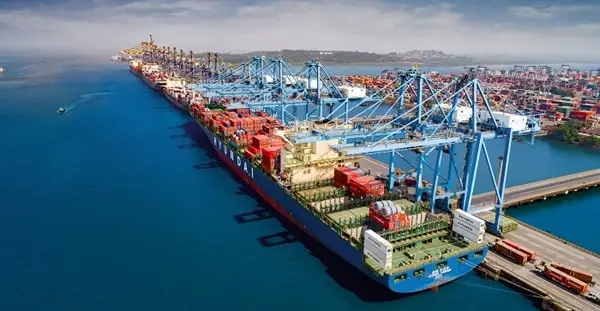India is one of the world’s largest peninsulas, with its 7517 km coastline. The Ministry of Ports, Shipping, and Waterways estimates that maritime transport accounts for 68% of India’s value trade and 95% of its volume trade. Under the Ministry of Ports, Shipping, and Waterways, most ports in India are fully owned by the government. In states with coastal regions, specific ports and infrastructures may be run by private organizations. 13 large ports—12 operated by the government and one by the private sector—and 187 notified minor as well as intermediate ports to serve it. The nation’s economy depends heavily on its seaports. In this article will examine India’s Top 10 Seaports.
1. Jawaharlal Nehru Port, Navi Mumbai

Mumbai is a major hub for exports and imports, with a large population and all the facilities needed to support trade. The JawaharLal Nehru Port, among India’s largest and busiest ports, is close to the country’s financial center. This port ranked 28th globally, handles 55% of all container freight that travels through India. 1989 saw the opening of the port. One of the first ports within the nation to be privately managed is the Jawahar Lal Nehru port, which DP World handles.
2. Port of Mundra
Mundra, India’s biggest private port, is a significant center for bulk and container freight. It started operating in 2001 and is managed by Adani Ports and SEZ Limited (APSEZ). It has excellent connections to all of India’s main hubs. The 8A Extension National Highway and the Mundra-Adipur railway line provide road-plus rail connectivity. The port can hold 338 million metric tons of cargo. The port uses ten dry bulk berths, three liquid bulk berths, six container berths, three mechanized import berths, and two SPM crude oil import berths. Wheat bagging plants, 97 holding tanks for liquid goods, coal processing stations, and a steel handling yard are examples of infrastructure specifically designed to handle items.
3. Port of Chennai
The biggest port on the Bay of Bengal coast used to be the Madras Port. The port of Chennai is the third oldest in India. Designated as the “Gateway of South India,” the port has operated since 1881 and has played a significant role in regional trade and economy. It has direct connections to more than 50 ports. The main imports are wheat, iron, raw cotton, machinery, and steel. More than 50 million tons of cargo are handled by this port annually, and plans are in place to expand its capacity to 140 million tons. There are 26 berths in each port’s three zones—North, Central, and South.
4. Visakhapatnam Port
The eastern ghats are home to Visakhapatnam Port, the cargo arrival hub. The largest harbor across all of Andhra Pradesh is the Visakhapatnam Port. The port’s advantageous location is further enhanced by its unique positioning between the ports of Chennai and Kolkata, one of the busiest areas in the nation. The port is already in the process of growing; RINL has started operating out of Vizag.
5. Cochin Port, Kochi, Kerala
The Cochin port in Kerala, which is around a century old, handles cargo from the Indian and Arabian oceans. The port was built by the British in 1928 to support trade with Gulf nations. The largest container facility within India, the international container transshipment terminal (ICTT), is in the Kochi port. Approximately 1500 vessels visit Cochin Port annually. This port has excellent access to highways, trains, and international airports.
6. Mumbai Port, Mumbai, Maharashtra
Mumbai’s port has a distinctive history and significance, making it one of India’s most well-known and identifiable ports. The port was founded by the British in the late 17th century and has been around for over three hundred years. The Mumbai port currently handles bulk and general goods. With over 400 square kilometers, the port has had over 41 births.
7. Paradip Port
Odisha’s only significant port, Paradip Port, is situated in the Jagatsinghpur district. It is built where the Bay of Bengal and the Mahanadi River converge. It was the first significant port to open on India’s east coast following independence and was named the country’s eighth-biggest port in 1966. Iron and coal ore are mostly carried at this port.
8. Tuticorin, Tamil Nadu
This is the fourth-biggest container terminal. With an ISO certification, the VOCP port accepts traffic from the USA, China, and the Mediterranean region of Sri Lanka. The port, the main exporter of agricultural products and raw materials, is barely 8 square kilometers in size. Now, the port oversees 0.8 million TEU units and 36 million tons of cargo.
9. Kolkatta Airport
The Kolkata Port, called the “Gateway of Eastern India,” handles freight from Australia and Southeast Asia. It makes use of the Kolkata docks and the Haldia docks dock systems. In addition to being a significant exporter of iron ore, steel, leather, copper, tea, and coal, it is the busiest port for the jute trade. Crude oil, heavy machinery, fertilizers, paper, chemical goods, and fertilizers are examples of imports. Ships up to 500 feet in length can be accommodated with ease at this naturally occurring river port.
10. New Mangalore Port
Located near Panambur, Mangalore, in the Indian state of Karnataka, New Mangalore Port, also called New Mangalore Port Trust, is an all-weather port with a total land size of about 480 hectares, or 1,186 acres. The deepest inner harbour on the west coastline is the New Mangalore Port.
Conclusion
India enjoys a significant commercial advantage; the governments have recognized this for years and consistently tried to upgrade port infrastructure. India is the export hub for a wide range of goods, and these ports facilitate the globalization of Indian goods.
FAQs
Q: Which is the only private major port in India?
Ans: India’s largest private port and special economic zone is the Port of Mundra.
Q: Which port is referred to as India’s gateway?
Ans: The Gateway of India overlooks the Arabian Sea and is situated on the waterfront in South Mumbai’s Apollo Bunder neighbourhood at the end of Chhatrapati Shivaji Marg.
Q: Who controls major ports in India?
Ans: The Union Shipping Ministry handles the major ports in India.

